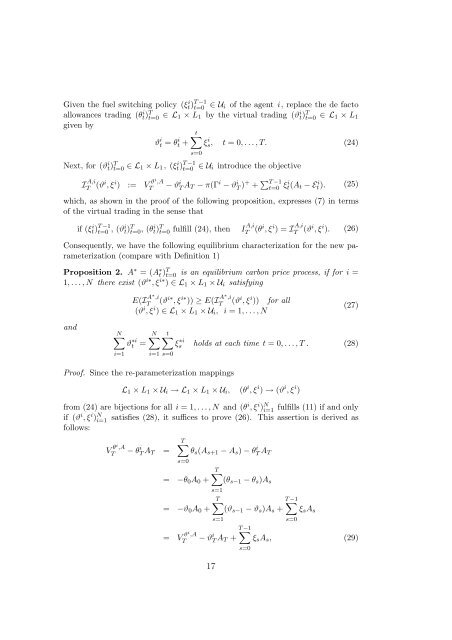A quantitative approach to carbon price risk modeling - CiteSeerX
A quantitative approach to carbon price risk modeling - CiteSeerX
A quantitative approach to carbon price risk modeling - CiteSeerX
Create successful ePaper yourself
Turn your PDF publications into a flip-book with our unique Google optimized e-Paper software.
Given the fuel switching policy (ξt) i T t=0 −1 ∈ U i of the agent i, replace the de fac<strong>to</strong><br />
allowances trading (θt) i T t=0 ∈ L 1 × L 1 by the virtual trading (ϑ i t) T t=0 ∈ L 1 × L 1<br />
given by<br />
t∑<br />
ϑ i t = θt i + ξs, i t = 0, . . . , T. (24)<br />
Next, for (ϑ i t) T t=0 ∈ L 1 × L 1 , (ξ i t) T −1<br />
t=0 ∈ U i introduce the objective<br />
s=0<br />
I A,i<br />
T (ϑi , ξ i ) := V ϑi ,A<br />
T<br />
− ϑ i T A T − π(Γ i − ϑ i T )+ + ∑ T −1<br />
t=0 ξi t(A t − Et). i (25)<br />
which, as shown in the proof of the following proposition, expresses (7) in terms<br />
of the virtual trading in the sense that<br />
if (ξ i t) T −1<br />
t=0 , (ϑi t) T t=0 , (θi t) T t=0<br />
fulfill (24), then IA,i<br />
T<br />
(θi , ξ i ) = I A,i<br />
T (ϑi , ξ i ). (26)<br />
Consequently, we have the following equilibrium characterization for the new parameterization<br />
(compare with Definition 1)<br />
Proposition 2. A ∗ = (A ∗ t ) T t=0 is an equilibrium <strong>carbon</strong> <strong>price</strong> process, if for i =<br />
1, . . . , N there exist (ϑ i∗ , ξ i∗ ) ∈ L 1 × L 1 × U i satisfying<br />
E(I A∗ ,i<br />
T<br />
(ϑ i∗ , ξ i∗ )) ≥ E(I A∗ ,i<br />
T<br />
(ϑ i , ξ i )) for all<br />
(ϑ i , ξ i ) ∈ L 1 × L 1 × U i , i = 1, . . . , N<br />
(27)<br />
and<br />
N∑<br />
i=1<br />
ϑ ∗i<br />
t =<br />
N∑<br />
t∑<br />
i=1 s=0<br />
ξ ∗i<br />
s holds at each time t = 0, . . . , T . (28)<br />
Proof. Since the re-parameterization mappings<br />
L 1 × L 1 × U i → L 1 × L 1 × U i , (θ i , ξ i ) → (ϑ i , ξ i )<br />
from (24) are bijections for all i = 1, . . . , N and (θ i , ξ i ) N i=1 fulfills (11) if and only<br />
if (ϑ i , ξ i ) N i=1 satisfies (28), it suffices <strong>to</strong> prove (26). This assertion is derived as<br />
follows:<br />
V θi ,A<br />
T<br />
− θ i T A T =<br />
T∑<br />
θ s (A s+1 − A s ) − θT i A T<br />
s=0<br />
= −θ 0 A 0 +<br />
= −ϑ 0 A 0 +<br />
T∑<br />
(θ s−1 − θ s )A s<br />
s=1<br />
T∑<br />
T∑<br />
−1<br />
(ϑ s−1 − ϑ s )A s + ξ s A s<br />
s=1<br />
s=0<br />
T∑<br />
−1<br />
= V ϑi ,A<br />
T<br />
− ϑ i T A T + ξ s A s , (29)<br />
17<br />
s=0
















